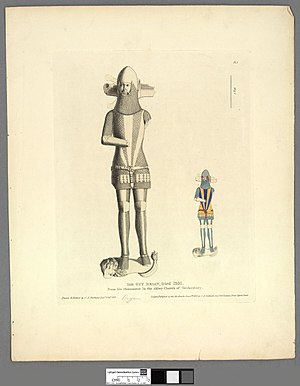Guy de Bryan, 1st Baron Bryan
Admiral Sir Guy de Bryan | |
|---|---|
 Guy de Bryan, 1st Baron Bryan (portrait from the Welsh Portrait Collection at the National Library of Wales. | |
| Born | 1319 Walwyns Castle, Pembrokeshire, Wales |
| Died | 17 August 1390 Gloucestershire |
| Buried | Tewkesbury Abbey, Gloucestershire, England |
| Allegiance | |
| Service/ | |
| Years of service | 1337–1372 |
| Rank | Admiral |
| Commands held | Admiral of the West |
| Battles/wars | Battle of Crécy Battle off Sluys |

Guy de Bryan, 1st Baron Bryan, KG (born before 1319, died 17 August 1390) was an English military commander and Admiral.
Origins
He was the son of Sir Guy de Bryan (d.1349) (alias de Briene), of Walwyn's Castle in Pembrokeshire and Torbryan in Devon he was sometime before 1319.
Career
He served on the English side in the Second War of Scottish Independence and in France and Flanders during the Hundred Years' War. In 1341, he was made Warden of the Forest of Dean, in Gloucestershire, and Governor of St Briavel's Castle, the seat of the Warden, which offices he held until his death.
On 26 August 1346 he was named a Knights Bachelor.[1]
In 1349, he was temporarily Keeper of the Great Seal of England, and in 1350 was granted an annuity of 200 marks for bearing the King's Standard against the French at Calais. From 25 November 1350, he was summoned to Parliament and may thereby be held to have been created Baron Bryan. On 1 March 1356 he was appointed Admiral of the West a post he held till 18 July 1360 under Edward III of England.[2] In 1361, he was Ambassador to Pope Innocent VI. Following the death of Sir John Chandos on 31 December 1369, he was made a Knight of the Garter. On 3 May 1370, he was once again appointed Admiral of the West until 6 October 1372.[3]
Marriages and children
He married twice and left children by his second wife only:
- Firstly, before 1348, to Joan Carew, daughter of Sir John Carew of Carew Castle, Pembrokeshire; childless.
- Secondly, before 10 July 1350, to Elizabeth Montagu (d. 31 May 1359), daughter of William Montagu, 1st Earl of Salisbury (by his wife Catherine Grandison), and widow of Hugh le Despencer, Baron le Despencer and of Giles de Badlesmere, 2nd Baron Badlesmere. By his second wife, he is known to have had at least five children, certainly three sons and a daughter, including:
Sons
- Sir Guy de Bryan (d.1386), who predeceased his father by four years and married a certain Alice (still living 20 May 1409) and had children:
- Sir William de Bryan (d.22 September 1395), married Joan FitzAlan, died childless[4]
- Philip de Bryan (d. pre-14 February 1388), died childless
Daughter
- Margaret de Bryan, wife of Hugh de Courtenay (d.1374) (son of Sir Hugh Courtenay, KG, and grandson of Hugh de Courtenay, 2nd Earl of Devon); childless[5]
Death and burial
Bryan died on 17 August 1390. Although he had a tomb in Tewkesbury Abbey, Gloucestershire, he was buried at Slapton Parish Church, Devon.
Succession
His executrix was his daughter-in-law Alice and his co-heiresses were his granddaughters Phillipe (age 12) and Elizabeth (age 10). Any barony that may be held to have been created by the writ of 1350 fell (according to modern doctrine) into abeyance between these granddaughters.[6] Sir Thomas Bryan assumed his arms at a later date.
Offices held
- Warden of the Forest of Dean, 1341.
- Governor of St Briavel's Castle, 1341.
- Keeper of the Great Seal of England, 1349.
- Admiral of the West, 1 March 1356 – 18 July 1360.
- Ambassador to the Holy See, 1361.
- Admiral of the West, 3 May 1370 - 6 October 1372.
References
- ^ Shaw, Wm. A. (1971). The Knights of England: A Complete Record from the Earliest Time to the Present Day of the Knights of All the Orders of Chivalry in England, Scotland, and Ireland, and of the Knights Bachelors. Vol. 2. Baltimore: Genealogical Publishing Company. p. 5. OCLC 247620448.
- ^ Connors, Michael (2008). John Hawley, merchant, mayor, and privateer : Chaucer's shipman of Dartmouth. Richard Webb. p. 67. ISBN 9780953636181.
- ^ Beatson, Robert (1788). A Political Index to the Histories of Great Britain and Ireland: Or, A Complete Register of the Hereditary Honours, Public Offices, and Persons in Office, from the Earliest Periods to the Present Time. G. G. J. & J. Robinson. pp. 260-262.
John de Norwich English Admiral.
- ^ The Early Owners of Torbryn Manor, J.J. Alexander, The Devon Association, 1936
- ^ "Britannia Biographies: Hugh Courtenay Le Fitz, Lord Courtenay". Archived from the original on 7 April 2001.
- ^ Complete Peerage, 2nd edition, Volume 2, PP 361-2
External links
 Media related to Guy de Bryan, 1st Baron Bryan at Wikimedia Commons
Media related to Guy de Bryan, 1st Baron Bryan at Wikimedia Commons- PEERAGE[Usurped!]
- KNIGHTS OF THE GARTER[Usurped!]
- celtic-casimir.com - celtic-casimir Resources and Information.
- Articles with short description
- Short description with empty Wikidata description
- Use dmy dates from April 2022
- Commons category link is the pagename
- 14th-century births
- 14th-century English Navy personnel
- 1390 deaths
- Barons in the Peerage of England
- English soldiers
- English admirals
- People of the Wars of Scottish Independence
- People of the Hundred Years' War
- Garter Knights appointed by Edward III
- Ambassadors of England to the Holy See
- Medieval English diplomats
- 14th-century English people
- 14th-century diplomats
- Peers created by Edward III
